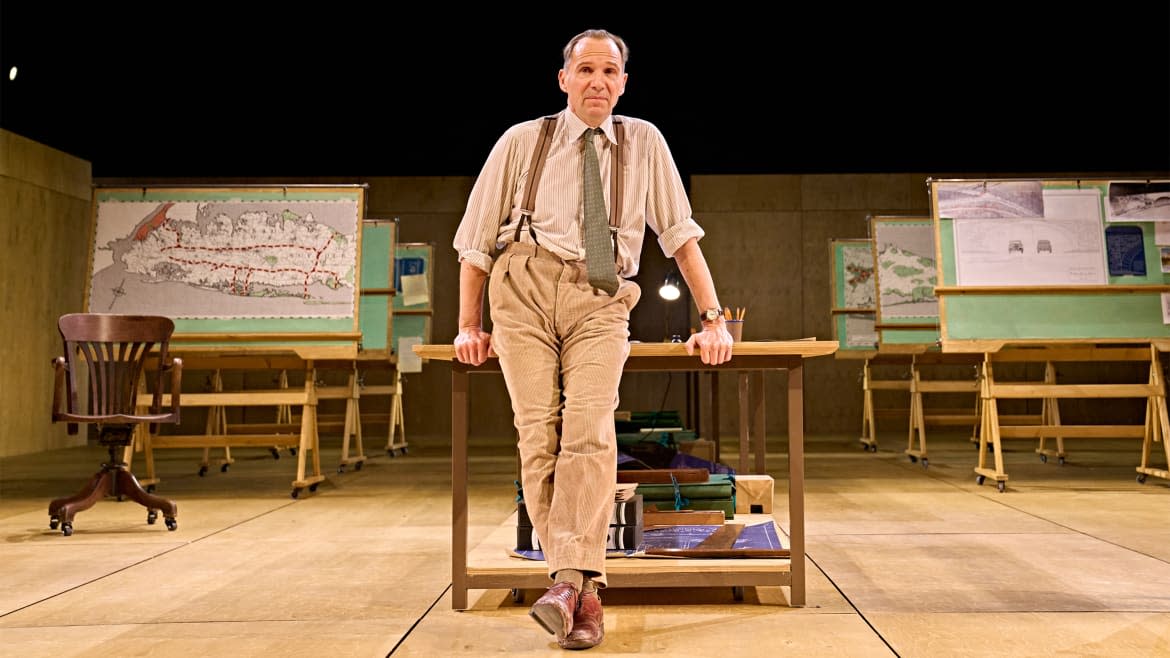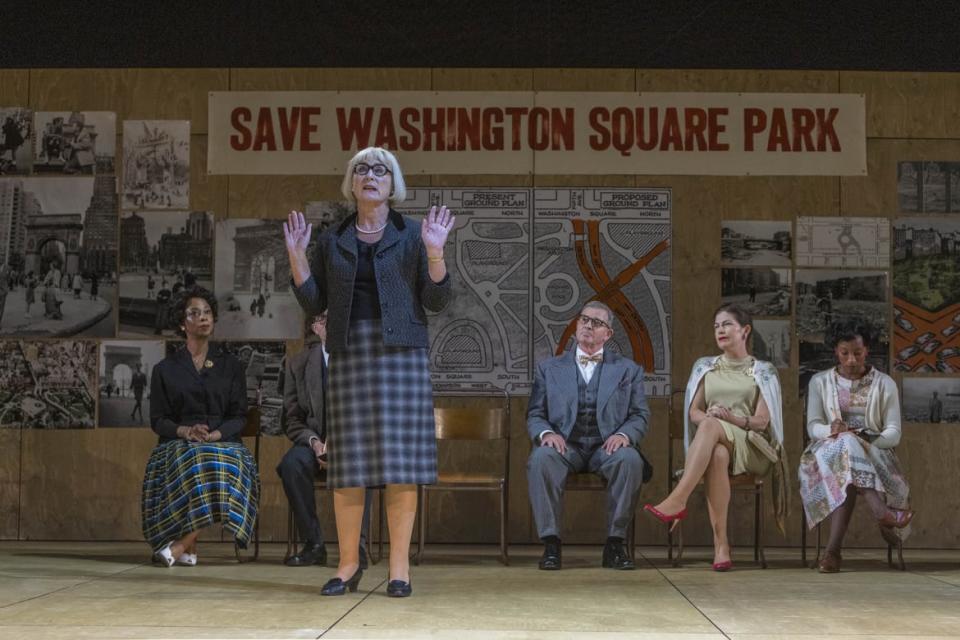In ‘Straight Line Crazy,’ Ralph Fiennes Turns ‘Master Builder’ Robert Moses Into a Big Bore

- Oops!Something went wrong.Please try again later.
- Oops!Something went wrong.Please try again later.
Ironies should abound in a play about Robert Moses, the urban planner, “master builder” and subject of Robert Caro’s iconic and devastating biography The Power Broker who reshaped New York over four decades as its most powerful public official despite getting crushed in his one attempt to win elected office himself.
Those ironies start and, regrettably, mostly end with Straight Line Crazy’s arrival this week from London to make its New York debut Off-Broadway (to Dec. 18) at the Shed in Hudson Yards.
Was Robert Moses the Original Donald Trump?
That’s the signature performance space in the new luxury neighborhood on Manhattan’s Far West Side erected over a multi-billion-dollar platform on top of a rail yard to fulfill the business community’s long-frustrated dream of expanding Manhattan’s sprawling office districts into what had been badly underused land on one of the world’s most valuable islands.
But three-and-a-half years after it opened, complete with a rare new train station, many of Hudson Yards’ pricey apartments are unoccupied as wealthy tenants fled for greener pastures during the pandemic, its anchor commercial tenant went bust and its signature public attraction, a 150-foot tall, 2,500-step stairway to nowhere called “The Vessel,” has been “temporarily closed” since a fourth person committed suicide by leaping off of it last July.
Unlike Lincoln Center, which was constructed by John Rockefeller III as a non-profit endeavor after Moses used eminent domain to claim and clear the “slums” of the existing community of San Juan Hill and push most of its mostly Black and Puerto Rican residents to upper Manhattan and the Bronx, Hudson Yards was the work of a single private developer.
That’s Trump ally Stephen Ross, who collected billions in government assistance including a new train station for his private and for-profit enterprise in an increasingly rare instance of something big and new actually getting built in New York in the absence of a Moses-like government official with the power to brutally accomplish such things with the interests of the broader public at least nominally in mind.
As it happens, Straight Line Crazy—referring to how Moses, as the Jane Jacobs character in the play tells the audience, “wanted to put a straight line between any two points and build where his ruler went,” of course including his infamous plan Jacobs helped foil for an expressway through the heart of Manhattan—is debuting just after Lincoln Center’s spectacular and sonically superior new $500 million David Geffen Hall opened last month with a multimedia show about San Juan Hill. (This is surely a reminder that if you succeed in bulldozing the “wrong” people out you can eventually afford to pay a loving and artistic tribute to the bulldozed before getting back to business.)
Such ironies are mostly lost, however, in Straight Line Crazy, buried despite some superb performances, solid direction, and smart, map- and model-heavy minimalist staging and quietly telling costuming by Bob Crowley, in a didactic and wordy script by playwright David Hare that’s full of lively asides about the orbits formed by powerful people and their functionaries but does so to advance a story that largely replaces insight and dramatic progression with urbanist fan service and “greatest hits.”
It’s in some sense the high-end version of a Marvel movie, with talented people hitting all of the necessary beats while doing nothing at all to disappoint the audience’s fixed expectations about the IP—in this instance perhaps from having read most of The Power Broker that one time or just nodding in recognition when TV talking heads have the hefty and recognizable tome as part of their Zoom backdrop.
The man with a plan
“Moses’ life is so prodigious and his reach so great that I have chosen to concentrate on just two decisive moments in his extraordinary career,” Crowley explains in a brief note at the top of his script, but those two moments, decades apart, don’t entirely connect, and in attempting to reduce this prodigious man who literally reshaped the Empire State and Gotham City down to those moments, all of the drama is lost in the vast elisions.
The play opens with real promise, on Long island in 1926 as a young Moses shows up uninvited at the estate of Henry Vanderbilt (Guy Paul) and more than holds his own against the oligarch as he aims to reclaim Nassau County from its aristocrats and open new public beaches and great roads leading to them to offer relief to the people of the city.
That’s followed by Moses in his Manhattan office laying out his unyielding vision to his functionaries, including Judith Roddy in the (made-up) role of Finnuala Connell, a young Irish woman with a mind of her own who’s drawn to Moses’ boldness of purpose, and finally—the high point of the play—a lengthy meeting in his office, with his staff watching, between Moses Gov. Al Smith, his political patron and hero and the closest thing New York produced to a Huey Long, a charming, hard-bitten rogue of a populist with ambitions of becoming the country’s first Catholic president.

"Straight Line Crazy."
There’s little drama here, but the acting is excellent, the dialogue crisp and the back and forth charming as Fiennes and Danny Webb, playing Smith as a crude sounding but savvy and charming operator, communicate through insults and asides and shows of affection and dominance as two vastly different types of men with a common understanding, all the while aware of the staffers silently taking it all in. It’s positively first-rate.
After that, however, the action jumps to 1955 and a flat second act where—spoiler alert if you’ve missed the last 70 years of New York history and 50 years of now ossified conventional wisdom about it—Moses’ plan to build an expressway and destroy the Village in the process, after his Cross Bronx Expressway devastated that borough, is stopped by Jacobs and a plucky group of “women mostly,” as he dismissively notes, “troublemakers [who] can’t read a technical drawing.”
According to the play, opposition to him was also very much in his office. Alisha Bailey plays Mariah Heller, a (made-up) young and ambitious Black woman working for Moses—who can’t much stand her—who tries to navigate being an agent of his power and speaking truth to him. Connell, who sees a lot of her young self in Heller, also seems to know from jump that Moses is doomed to fail, that he’s racist and car-crazy and more, and many characters endlessly inform Moses, and the audience, of all that.
Fiennes, in a great display of both physicality and feebleness, has his Moses march on—heedless as his staff and Jacobs, played by Helen Schlesinger as more a type than a person and functioning as both narrator and character, hammer home the folly and futility of his vision to inflict great new roads on unappreciative New Yorkers.
In both acts, Fiennes and Roddy, locked in their platonic office marriage, are superb, with each making subtle physical adjustments to aptly reflect 30 years of wear. Eventually and predictably Connell has enough and leaves, while Moses marches blindly on, still “straight line crazy.”
And that is about that, with a viewer who doesn’t already know Moses with no way at all to understand how an ambitious young man using the state’s power to open up the beaches to city dwellers became a rigid old man contemptuous of those same city dwellers.
New York could use a Moses for the story of Robert Moses
“Every generation writes its own history,” Kenneth T. Jackson, the magisterial historian of New York City, wrote in 2007, noting that while The Power Broker reflected a New York that had been in decline for 15 years, when it was published in 1974, “a lot of big projects are on the table again, and it kind of suggests a Moses era without Moses.”
That’s indeed come to be in flawed projects like Hudson Yards and in the great difficulty in getting new train lines or buildings or other large-scale plans built and in transforming what’s already here—in large part because of the sometimes bananas safeguards put into place to stop another figure like the powerbroker from simply imposing their plans..
But at a moment after the COVID shutdown when the city and state are facing great uncertainty and challenges ahead, New York is still telling tales about the dangers of a Robert Moses even as it could use a Moses for affordable housing, a Moses for saving the trains, a Moses for transforming streets and ending the dominance of cars.
One more irony: New York could use a Moses for the story of Robert Moses, one able to connect his accomplishments, for good and ill, with the sort of vision needed now to ensure Gotham City and the Empire State’s best days aren’t behind them instead of putting on new versions of an morality tale as a sort of comfort food.
Get the Daily Beast's biggest scoops and scandals delivered right to your inbox. Sign up now.
Stay informed and gain unlimited access to the Daily Beast's unmatched reporting. Subscribe now.

